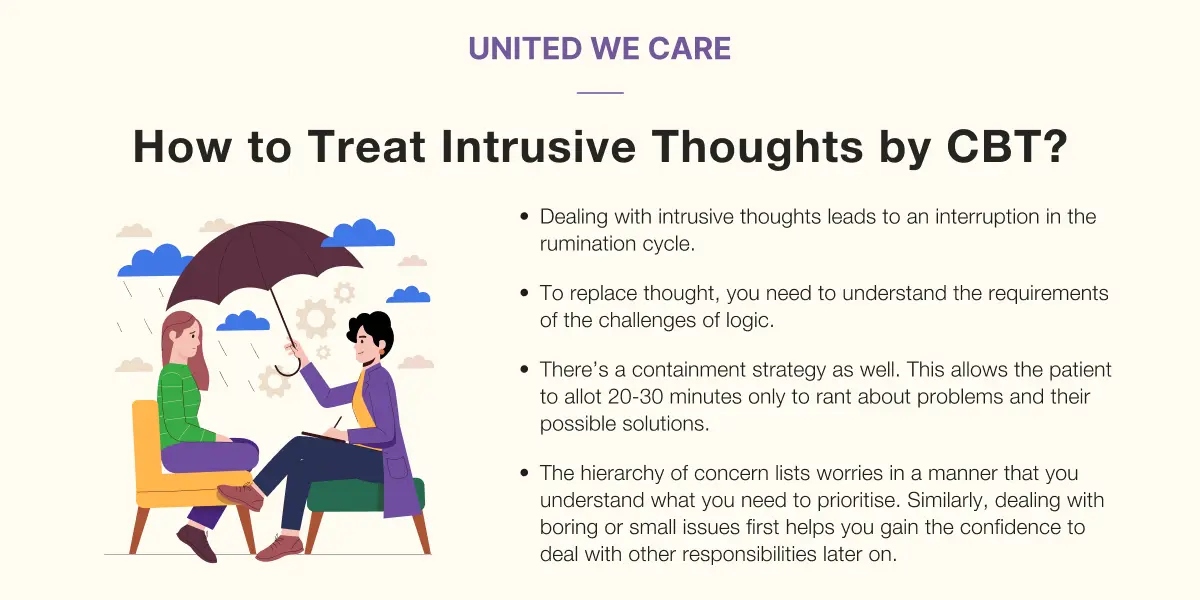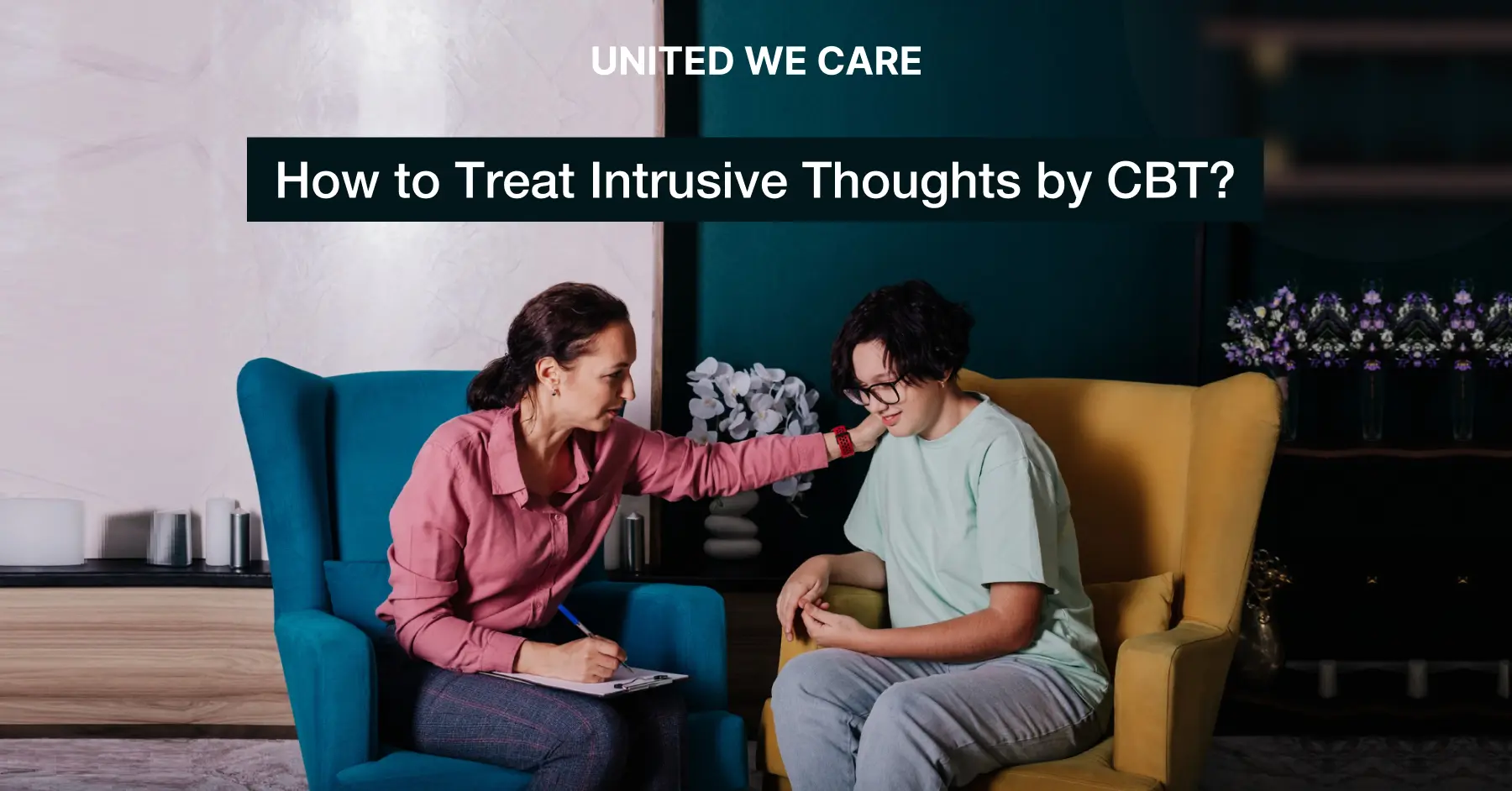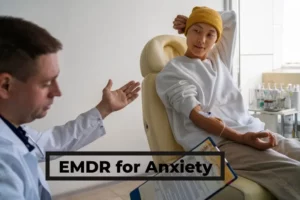Introduction
Intrusive thoughts are repetitive, unwanted, and disturbing thoughts that can lead to feelings of anxiety and uneasiness. Along with this, while prevention, they make you feel stuck and lead to unhealthy coping mechanisms and other avoidant practices. Some of these are either inappropriate thoughts about either violent imagery or self-critical scenarios.
CBT for Intrusive Thoughts
Cognitive Behavioural Therapy has been proven to help with multiple mental health issues. For the cases of intrusive thoughts, it guides you regarding tools to cope with intrusive thoughts and, additionally, techniques. It is to be noted here that its base relies on the concept of constantly changing ingrained thought patterns.
CBT involves exposure and response prevention (ERP), which, with time, teaches you to decrease the effect thoughts have on you. Wondering how? You’re exposed to your feared thoughts as a patient, and your urges in response are restricted strictly. With this in mind, it is important to understand the requirement of management of positive thought processes.
To achieve that, you must go through cognitive restructuring. It acknowledges and further deals with it by making the illogical thoughts go away. Rather, it replaces them with more control over thought and optimist thought patterns.
Why CBT is Good for Intrusive Thoughts
CBT decreases stress and helps people first recognise what negative thoughts they have, how to handle them, and how to calm down. Not just this, but also, because of the replacement of distress over intrusions, it helps. You commit to managing yourself through strategies that work for a longer period.
It builds control in you and adjusts cognitive biases and the way you react. It alters thought patterns and changes your regular negative habits. It makes you better at dealing with underlying issues of OCD and anxiety as well.
It is generally collaborative and puts a client in control of one’s thoughts. Through CBT, you become conscious enough not to give in to the negative or provoking intrusive thoughts. Not just while practising it but through homework and tools, it leaves its impact for the longer term. And leads to overall empowerment of the person.
How Does CBT Work for Intrusive Thoughts
CBT provides many benefits but only at the cost of a procedure that goes behind it.
- To treat underlying intrusions that might be hard to recognize and talk about, thought records are used. It uses it to challenge distorted thinking patterns and lets logic lessen its grip.
- To deal with intrusive thoughts in moderation, graded exposure therapy comes into play. Furthermore, until you are desensitized to it, you are exposed to your thoughts and denied compulsions at a normal pace. This prevention of compulsion eventually helps you in stopping avoidance as well.
- Not just from the surface, but Cognitive Behavioural Therapy additionally gets to your core and addresses core issues. It manages growing signs, which gives the outcome a hierarchy of concerns and problems that can still be prioritized and solved. This method helps with the reduction of anxiety and reconstructs the way your habits perform over time.
How to Treat Intrusive Thoughts by CBT
Mindfulness meditation focuses on the present. Let thoughts pass without judgment. Builds healthy detachment from content.
To treat intrusive thoughts by CBT, here are some following points for a better understanding:

- Dealing with intrusive thoughts leads to an interruption in the rumination cycle. To demonstrate so, visualise an image, shout “stop,” or mark on a paper every time some thought hits you. This replacement of thoughts is the key that will help.
- To replace thought, you need to understand the requirements of the challenges of logic. This is where thought records come in to help. It writes out thoughts, emotions, and even evidence for further understanding.
- There’s a containment strategy as well. This allows the patient to allot 20-30 minutes only to rant about problems and their possible solutions.
- As discussed before, the hierarchy of concern lists worries in a manner that you understand what you need to prioritise. Similarly, dealing with boring or small issues first helps you gain the confidence to deal with other responsibilities later on.
Conclusion
This Cognitive Behavioural Therapy tailors your strategies and targets thought patterns that make you feel uneasy with your intrusive thoughts. Mindful procedures like this help clients manage themselves better. And just because no size fits all, every adjustment is made to individual thought, and that’s why CBT practicing therapists have custom programs.
However, it is not a quick fix, and it takes its time to help oneself. But eventually, you can overcome the intrusive thoughts or at least make some progress in managing them.
Along with strategies, regular practices, and commitment to a thought pattern, it can be made more effective when combined with medications. If you face severe OCD or anxiety symptoms while going through it, it is best to consider it.
Also, CBT tackles different aspects, so it is important to make sure that an integrative approach makes your chances better and helps you make the most out of it. You can always look for more resources at United We Care.
References
- A. Belloch, C. Morillo, and G. Garcia-Soriano, “What do others think? The why, when and how of using surveys in CBT,” *Behavioural and Cognitive Psychotherapy*, vol. 38, no. 1, pp. 1-15, 2010.
- M. H. Freeston, R. Ladouceur, N. Thibodeau, and F. Gagnon, “Perceived Control and Appraisal of Obsessional Intrusive Thoughts: A Replication and Extension,” *Behaviour Research and Therapy*, vol. 29, no. 5, pp. 425-433, 1991.
- G. Garcia-Soriano, A. Belloch, C. Morillo, and D. A. Clark, “The assessment of unwanted intrusive thoughts: A review and critique of the literature,” *Clinical Psychology Review*, vol. 31, no. 8, pp. 1258-1270, 2011.
- J. D. Huppert and J. Siev, “Best practices for CBT treatment of taboo and unacceptable thoughts in OCD,” in *Obsessive-compulsive disorder: Subtypes and spectrum conditions*, J. Abramowitz, D. McKay, and S. Taylor, Eds. Elsevier, 2010, pp. 209-226.
- B. O. Olatunji, M. L. Davis, M. B. Powers, and J. A. J. Smits, “Cognitive-behavioral therapy for obsessive-compulsive disorder: a meta-analysis of treatment outcome and moderators,” *Journal of Psychiatric Research*, vol. 47, no. 1, pp. 33-41, 2013.
- P. M. Salkovskis, A. Hackmann, A. Wells, M. G. Gelder, and D. M. Clark, “Cognitive-behavioral therapy for intrusive thoughts in patients with obsessive-compulsive related disorders: A randomised controlled trial,” *American Journal of Psychiatry*, vol. 164, no. 4, pp. 629-631, 2007.










